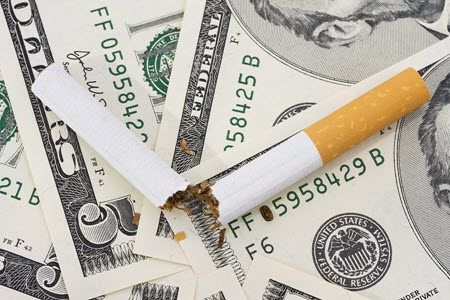TRDRP-funded studies show that tobacco control programs funded through tobacco excise taxes have led to reduced smoking rates, fewer smoking-related illnesses, and reduced healthcare costs for the state
In 2010, TRDRP funded three independent analyses of the statewide investment in tobacco control and its effect on smoking rates in California and the associated health and economic costs. The studies showed that the California tobacco control program, which is funded primarily through tobacco excise taxes, has directly contributed to the lower smoking rates and fewer lung cancer diagnoses that we enjoy in CA compared with the rest of the country. Between 1989 and 2008 the state invested $2.4 billion in tobacco control resulting in a whopping savings of $134 billion in healthcare costs. The studies also showed that an increase in that investment, which would have occured if the proposed $1 increase in tobacco tax had been adopted in 2012, would have led to a savings of over $3 billion in smoking-related healthcare costs between 2012 and 2016.
In light of the changing landscape of tobacco use, access to healthcare, and the California economy, the economic models developed for those studies were recently updated with current data, including the proposed $2 increase in tobacco taxes that was recently approved by California voters (Proposition 56). See the links below for more detail.
Links to newly updated studies:
- "Update on the Effect of the California Tobacco Control Program" - Dr. John Pierce & Dr. Yuyan Shi (Univ of CA, San Diego)
- "The Effect of a $2.00 Per Pack Increase in the Tobacco Excise Tax on Smoking and Healthcare Expenditures: 2017-2020" - Dr. Wendy Max, Dr. Hai-Yen Sung, & Dr. James Lightwood (Univ of CA, San Francisco)
- "Economic Impact of the California Healthcare, Research and Prevention Tobacco Tax Act of 2016: Job creation and economic activity" - Dr. James Lightwood and Dr. Stanton Glantz (Univ of CA, San Francisco)
- One-page summary of the results from the UCSF studies
Links to previous studies:
- "Forty Years of Faster Decline in Cigarette Smoking in California Explains Current Lower Lung Cancer Rates" - Pierce et al. (2010) Cancer Epidemiol Biomarkers Prev; 19(11)
- "The impact of changes in tobacco control funding on healthcare expenditures in California, 2012-2016" - Max et al. (2013) Tobacco Control; 22(e1)
- "The Effect of the California Tobacco Control Program on Smoking Prevalence, Cigarette Consumption, and Healthcare Costs: 1989–2008" - Lightwood & Glantz (2013) PLoS ONE; 8(2)

